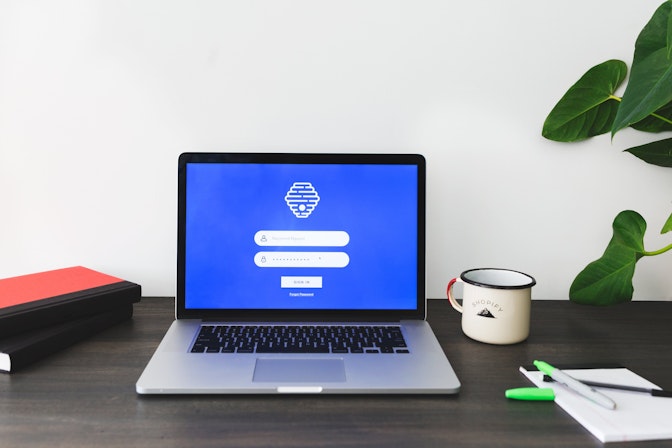Today’s online shopper wants personalized experiences. Market segmentation, also called customer segmentation, is a great way to deliver them. While it’s an important strategy for any ecommerce company, many store owners and marketers find themselves asking, “What is market segmentation?”
It’s a way for store owners to separate their visitors into different groups. This way, they can create a more personal experience based on the customers’ traits, behaviors, needs, and desires. Many brands that use market segmentation in their marketing plan make more money, have happier customers, and perform better against their competitors.
Research from DMA found that marketers who used segmented campaigns saw a 760% boost in email revenue.
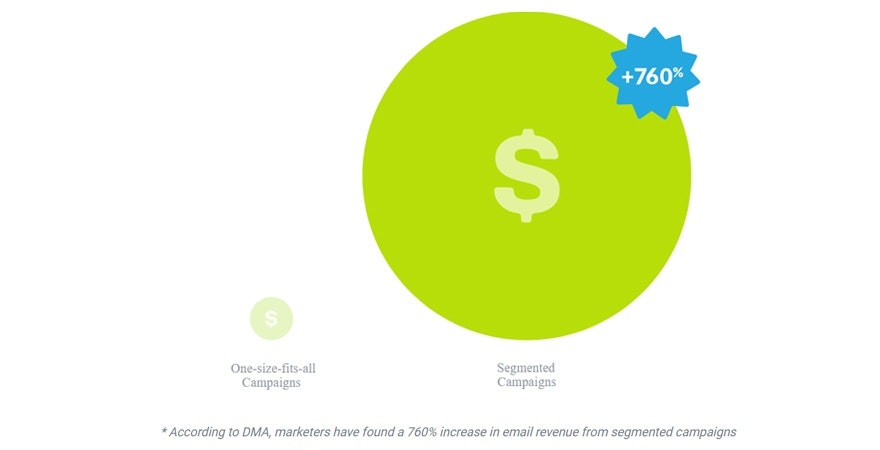
Source: Campaign Monitor
There are many tools and strategies that you can use to segment your customers and create an awesome shopping experience. If you can keep this experience consistent every time they shop with you, you can build loyal customers. This guide will explain different strategies, examples, and tips to help you grow your business with market segmentation.
What is Market Segmentation?
Market segmentation is when you divide your visitors and customers into segments, or groups, based on qualities that they have in common. There’s an infinite number of ways to divide your customers into groups. That’s why your own market segmentation definition can – and probably will – be different from your competitors.
Here are a few customer segmentation examples to make different customer groups:
- VIPs: customers who shop the most often or who spend the most money
- Active, long-time users who are recurring customers
- Reactivated customers, who made a purchase, became inactive for a while, then made another purchase
- Low-tier, recurring customers who shop less often and spend less money
- New customers who just made their first purchase
- New visitors who just registered for your mailing list without making a purchase
Here’s an example of how it could affect your revenue:
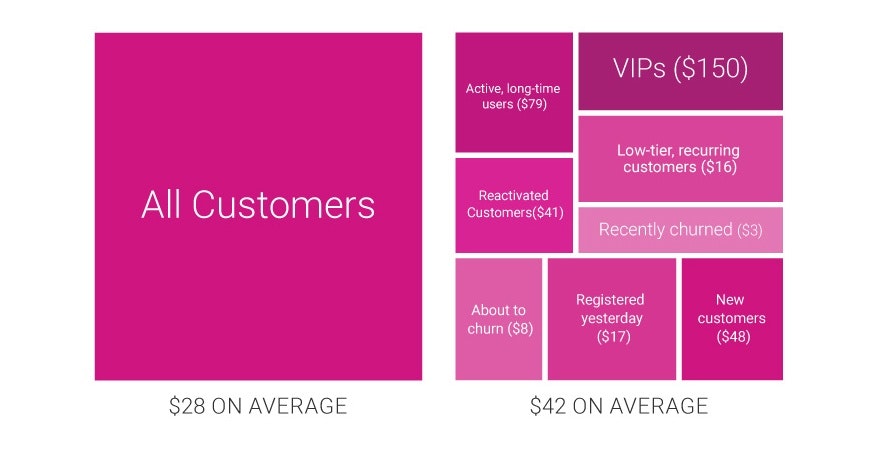
By dividing all of your customers into smaller groups, you can target your customers better than if you used one basic strategy for everyone. This creates a better user experience for each type of customer, which causes them to spend more money and keeps them happy.
The goal is to find shopping patterns in certain groups. For example: do you sell more winter boots to customers who live in countries and regions where it snows? Do you sell more vitamins to people over the age of 50? Do customers spend more than $200 in one order when they’ve already visited your site one or two times before? Do your loyalty program members favor a free shipping promotion over a 20% sale?
Once you find the patterns and make connections, you can use these groups in your marketing efforts. Popular ways to use market segmentation are in email marketing, online advertising like Facebook Ads and Google AdWords, and A/B testing for your website.
Benefits of Market Segmentation
Today’s online shopper has access to fast technology and thousands of website options to buy what they want. Over the past decade, this has created a huge demand for a personalized shopping experience. In fact, one study found that 64% of shoppers want personalized offers. If the experience isn’t personalized, 52% said they’re likely to shop at another store.
And it’s paying off. According to eMarketer, 48% of U.S. marketers said that when they personalized their websites and apps, it brought their revenue up 10% or more.
Here are some of the top results that showcase the importance of market segmentation:
It saves you time and money. Instead of using one generic strategy for all of your customers, market segmentation can help you to cater your efforts to specific groups of people. This means you won’t be wasting time and money on ineffective campaigns, because your efforts will be targeted and based on customer data.
It builds better relationships with your customers. The process of market segmentation involves constantly learning more about your customers. The more you learn about them, the better you can serve them and create the perfect shopping experience.
It helps you identify your brand’s strengths, weaknesses, and opportunities. Customer segmentation can show you how your brand and campaigns are performing. You can see performance down to how popular an item is in a customer segment. You’ll learn which parts of your strategy are strong, which ones need improvement, and how you can compete better against your competitors.
4 Types of Market Segmentation and Market Segmentation Examples
There are 4 main types of market segmentation: demographic, geographic, behavioral, and psychographic. Focus on them when you’re trying to improve the customer experience for your shoppers.
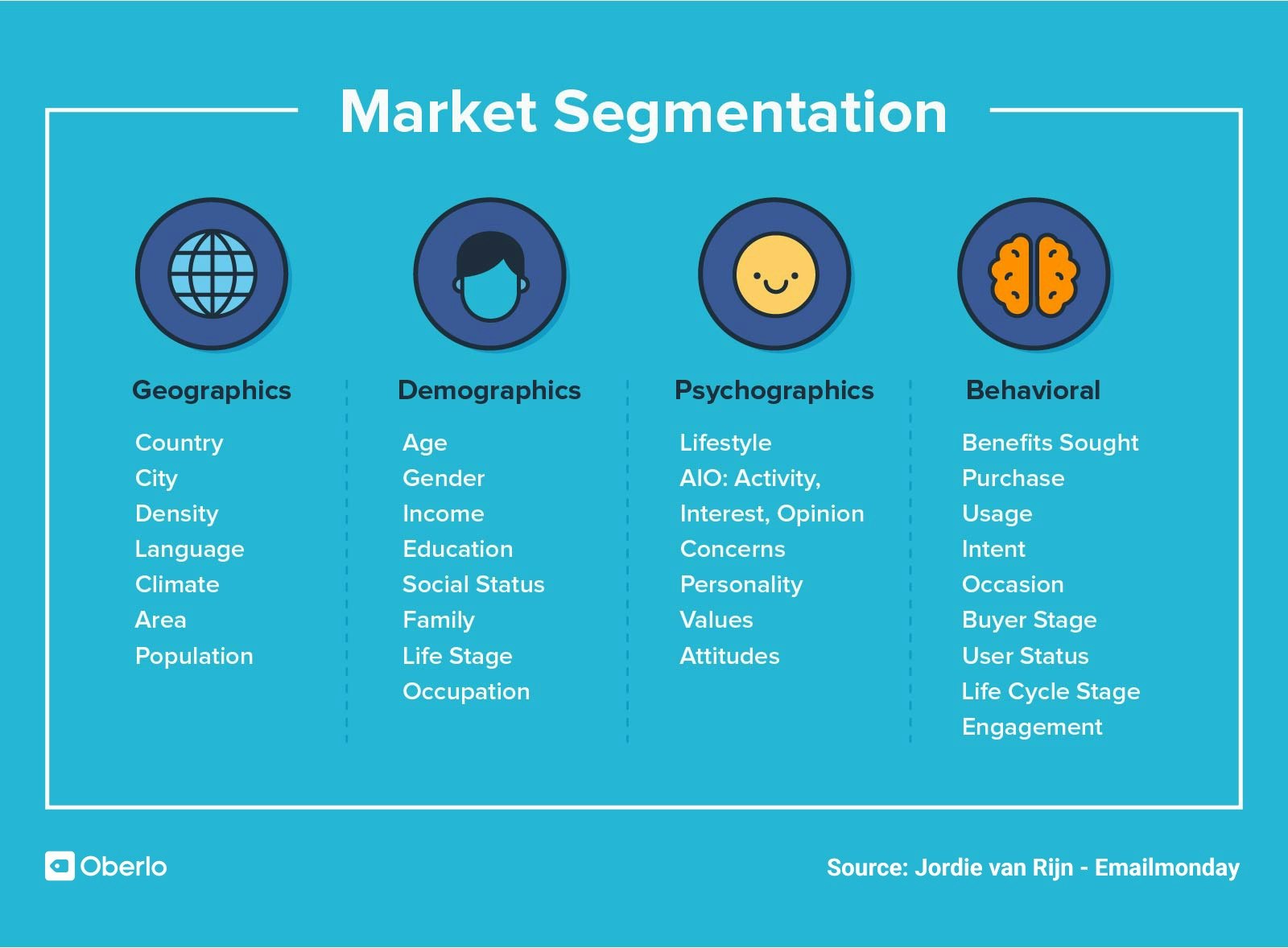
Source: Pillars of Segmentation – Jordie van Rijn
Demographic
Demographic market segmentation is when you divide your customers into groups based on their demographic information, such age, income, gender, education level, single or married, family size, race, job title, religion, and more.
Demographic segmentation is the most popular type because it’s the easiest and most reliable way to divide customers.
Dormify is a dormitory and apartment décor company that focuses on college students decorating their dorms and homes. The company wanted to market a special collection of accessories and clothing for women who were members of sororities – a more specific demographic than just women in college.
The marketing team looked at the company’s data to see who interacted with sorority and “Greek life” emails and advertisements. Then they used this information to create a list of people who would receive the sorority product emails.
Through this and other segmentation efforts, Dormify grew its email marketing revenue by 92%.
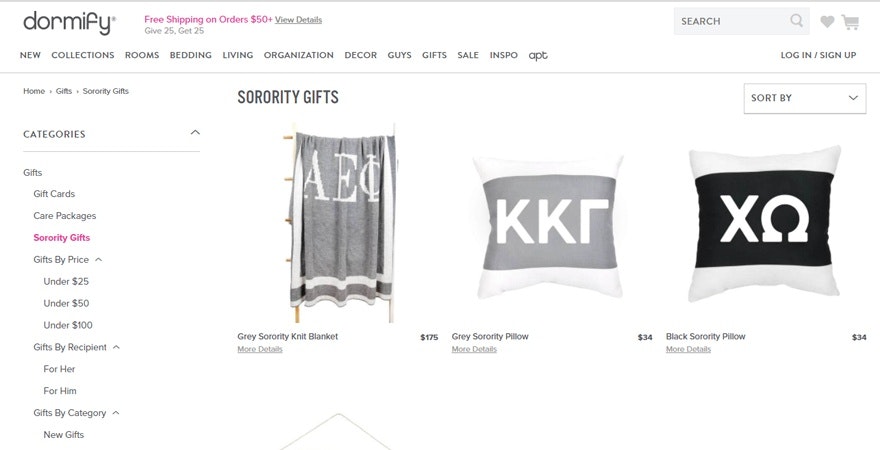
Geographic
Geographic segmentation is when you separate customers based on where they are. If you’re an international store, this can be by continent or country. You can also segment them by region, state, city, and even neighborhoods or areas inside a city. For example, Brooklyn, Manhattan, and Queens are neighborhoods of customers who live in New York City.
Patagonia, an outdoor clothing and gear company, is known for hosting local events in cities with a strong customer base. The company hosted an event in Upper West Side, Manhattan at one of its stores. It invited customers to browse a photo gallery, drink beer from a local brewer, and even meet the artist. While Patagonia has stores across the United States, this email was sent to the company’s subscribers who live in the area and were within traveling distance to attend.

Source: MailCharts
Behavioral
This method makes groups based on a customer’s behavior online, like:
- How they use your website (which pages they visited, which links they clicked, what time they shop, when was the last time they shopped, etc.)
- What they know about your products (are they still learning or ready to make a purchase?)
- How they use your products (do they come back often to refill their supply or get more?)
- How they make decisions (are they impulsive or slow to buy?)
For example, some customers spend months learning about a product before they buy it, while some customers are “impulse shoppers” who buy it right when they see it. Some people want to go to a physical store to see the product in person, while some people always buy online. When you know how your customers behave, it’s easier to give them what they want.
Echo Club House (formerly SwayChic) made 12 targeted email campaigns. One of the things they looked at was what times their customers shop. So they created a time-based campaign that sent emails out at 5 a.m., 10 a.m., and 5 p.m. for the most popular purchase times. Another segment was based on engagement. It included shoppers who bought one time, repeat customers who bought three or more times, customers who made a purchase more than 6 months ago, and more.
With this new strategy, Echo Club house increased their email open rate by 40%. They also got double the rate of click-throughs inside the emails and earned triple the revenue compared to their earlier campaigns.
Psychographic
This strategy is about a customer’s beliefs, values, personality, and lifestyle. All of these traits can affect their shopping decisions. Psychographic groups might be a mix of other types of segmentation, like their age or religion (demographic) or their location (demographic). These details often play a role in a person’s attitudes and lifestyle.
For example, you might find that millennial customers, or customers who were born between 1981 and 1997, are more likely to buy organic, “all natural,” or eco-friendly products.
Women’s retailer Intermix used their customer data to make 3 segments related to the customers’ purchase patterns. These segments were:
- VIP customers, who made more money and liked to buy the latest trends. These customers received exclusive invites to special events.
- Sale shoppers, who made more purchases when there was a discount. These customers received 30% discounts.
- Brand shoppers, who were loyal to certain brands and are willing to spend a little extra for them. These customers received 10-15% discounts on their favorite brands.
Intermix increased their yearly revenue by 15% with these segments in their email marketing plan.
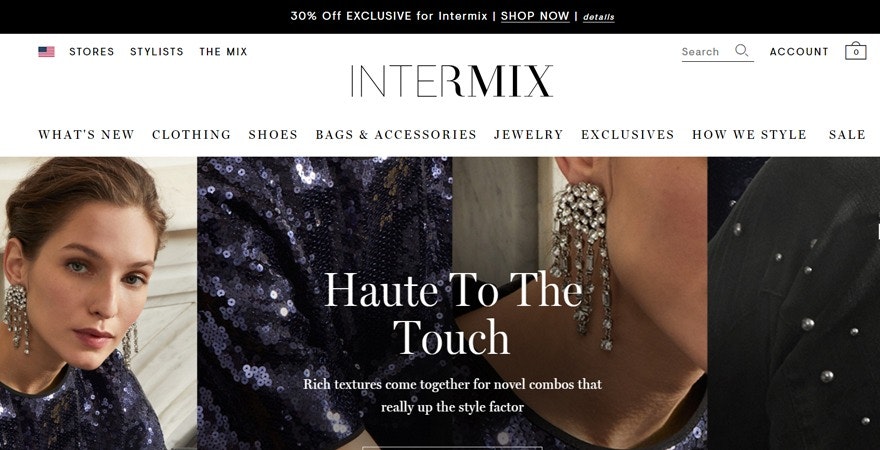
How to Master Customer Segmentation in Email Marketing
Let’s look at a 5-step approach:
Step 1: Look at Your Data
Data analysis is the core of your plan. The data you need will depend on the segments you want to create. You can find loads of helpful information in Shopify Analytics and Google Analytics. This information can cover any of the topics we discussed earlier, like demographic information of each user and how they interacted with your website.
Step 2: Choose Your Segments
Take some time to think about your main business goals. Think about your best-selling items, your locations with the most orders, and the people who buy the most products from your store. How can you divide these up into separate groups?
Step 3: Use Your Email Marketing Tool
An email marketing tool can be your best friend. Try integrating your email provider with your Shopify store.
Once it’s connected, you can set up segments based on your store data. This can include pre-built customer segments like potential customers, recent customers in the past 30 days, and inactive customers who haven’t made a purchase in 8 months.
You can also build custom segments based on criteria like:
- Total number of orders (how many times a customer ordered from your store)
- Average number of products in each order
- Vendor purchased (for specific categories of items – helpful if you want to promote related items)
- Past purchases (to track specific items that they bought – helpful to promote related items)
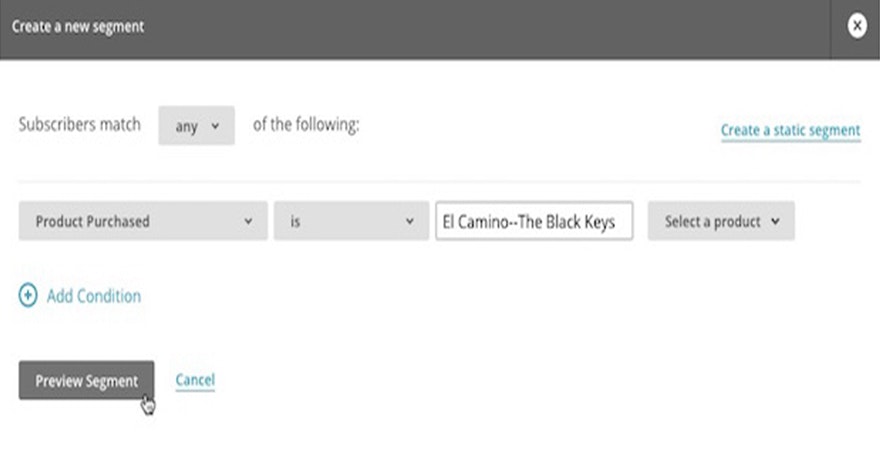
- Total number of products ordered
- Amount spent on a single order
- Average amount spent on each order (if they made multiple purchases)
- Total amount spent across all orders
- Customers who have made a purchase or have not made a purchase (helpful if you want to target customers who have not bought anything yet)
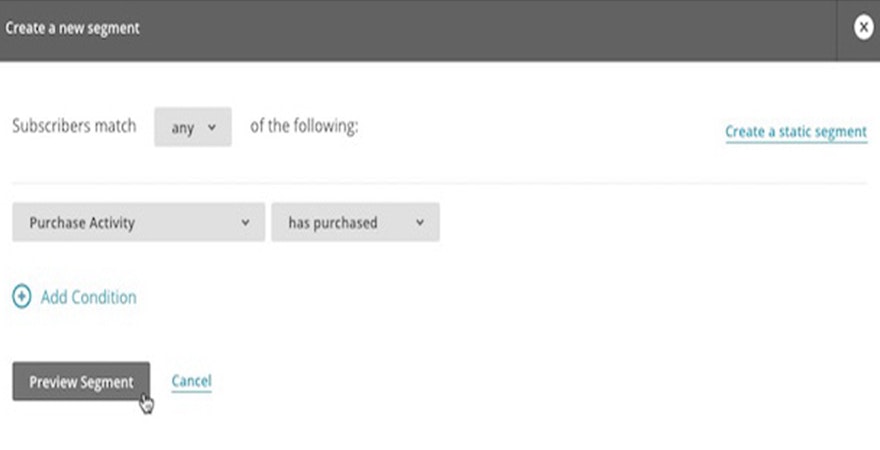
- Date of purchase
- ZIP code of the customer’s address
- A combination of any of the above criteria
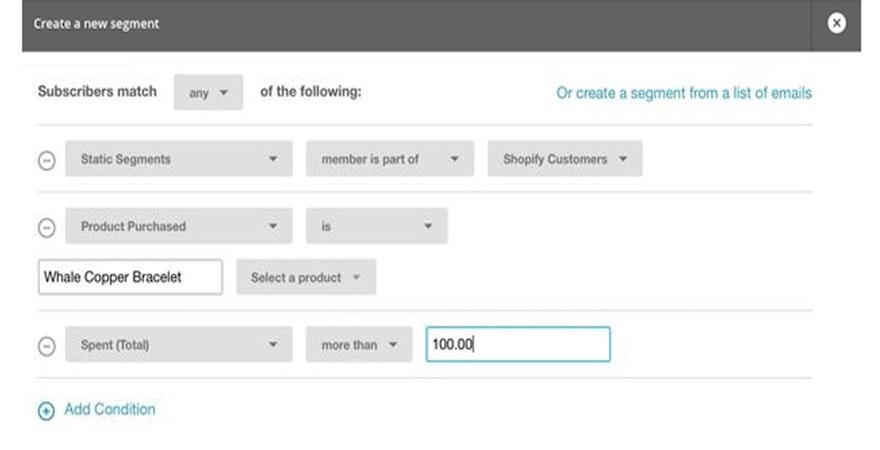
Step 4: Create Your Content
Now that you have an idea of how you want to divide your segments, you can start creating content to send out in your emails. Get creative – there’s no limit to how you can use customer segmentation.
Use photos and eye-catching visuals to get your customers’ attention. This can help them visualize your offer, which makes them more likely to click through if they’re interested. Special sales promotions and discounts are another successful way to sweeten the deal.
See this email for women’s apparel sent out to Rita Ora’s female subscribers.
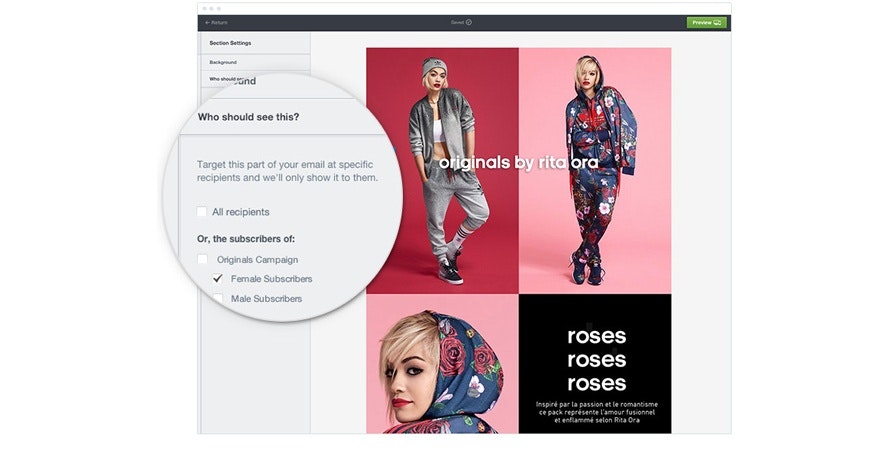
Source: Kissmetrics
Luxury bedding store Brooklinen sent an email offering free shipping. It showed products that the customers looked at on their website but did not purchase. The added shipping offer is a perfect way to convince the user to finally make the purchase.
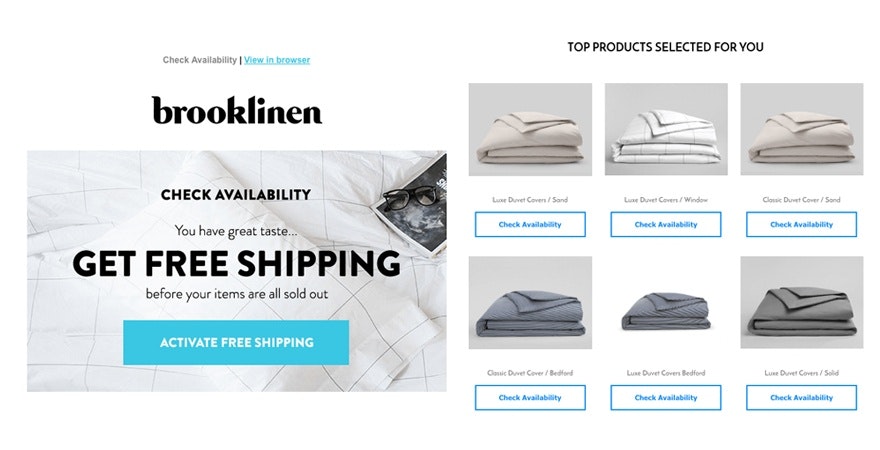
Source: Campaign Monitor
Smart Bargains sent out this clever email to bring back old, inactive customers who have not made a purchase in a while. The email headline says “Sorry it’s been so long.” Then, the company offers an extra 25% off the whole website for 2 days only. This creates a sense of urgency for the customer to shop now.
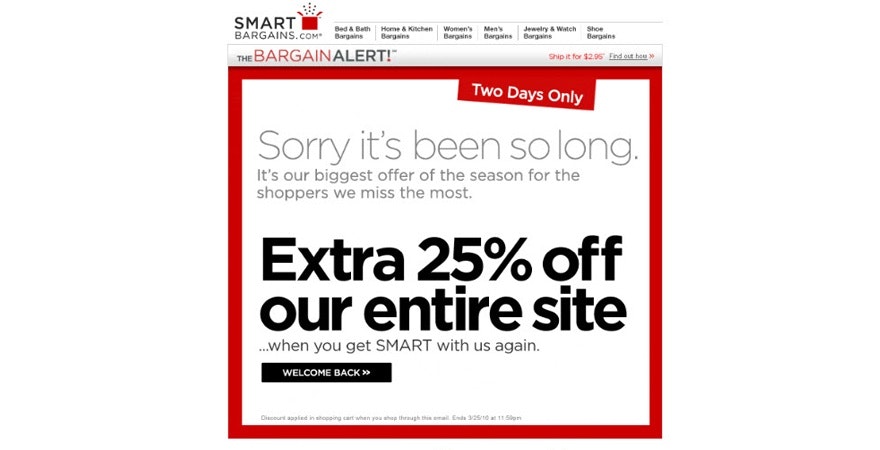
Source: Remarkety
Step 5: Start Emailing and Tracking Results
When you’ve segmented your customers and designed your emails, you’re ready to send. It’s important to keep tracking your results and data so you can start the whole process over again. Look at who opens what, which emails lead to purchases, and other patterns that you can pick out.
For example, if you find that pictures are improving click-through rates, you know to use more of them. If your VIP customer demographic spent 25% more, you know to pay special attention to those relationships.
By sending emails, you’re adding more data to your database. In turn, you have more up-to-date and accurate information to keep growing and tweaking your market segmentation plan.
How to Find Your Customer Segments in Facebook Ads
Facebook advertising is a powerhouse for ecommerce companies. In fact, it’s responsible for 85% of ecommerce orders on social media. So it’s good news that Facebook Ads offers awesome options for customer segmentation.
There are 3 segmentation options: core audiences, custom audiences, and lookalike audiences.
Core Audiences
Core Audiences let you segment Facebook users manually. You can find criteria for all 4 types of market segmentation that we discussed earlier.
You can mix-and-match whatever options you like. This gives you incredible power to find very specific segments.
Choose from options like:
- Location (geographic): Target by country, state, ZIP code, or even an area around a physical store (for example, a 30-mile circle around it).
- Demographics: The details discussed earlier, like age, gender, education, job title, family size, and language they speak.
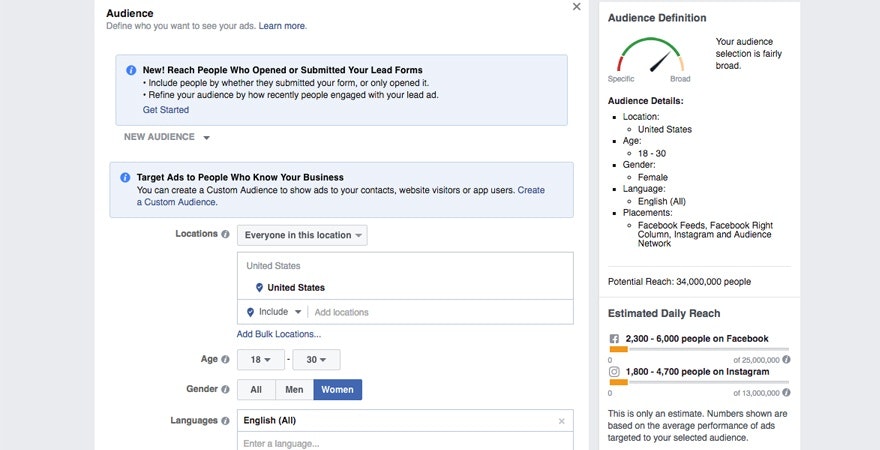
- Interests (psychographic): Things each user has “liked,” “followed,” or listed as an interest in their profile. This includes shopping, food, fitness, movies, music, sports, games, and many more.
- Behaviors (behavioral): What they do on Facebook, including how they shop, what they’ve purchased recently, whether they log on from their phone or desktop computer, if they travel, if they watch TV or listen to satellite radio, and much more.
- Connections: You can segment people who like your page (as well as their Facebook friends), people who use your app, and people who have attended one of your events.
Custom Audiences
Custom Audiences allows you to upload your store’s customer data into Facebook. This gives you an additional way to target your customers and leads, which increases the chances they’ll make a purchase.
You can use:
- Contact lists: Upload a contact list that includes details like email addresses and phone numbers. Facebook will try to find their profile so you can target them with your ads.
- Website visitors: Create a custom audience of people who visit your store and use their browsing data to show them relevant ads on Facebook. Do this by installing the Facebook pixel on your site.
- App users: If you have a mobile app, install the Facebook SDK in your app to connect your users to your Facebook Ads account.
To create a custom audience, go to the “Audiences” tab in the Ads Manager and click “Create Audience” → “Custom Audience” → “Customer List.” Then upload a CSV or TXT file that lists your contacts. Be sure to select which customer data points your file contains, like first name, last name and email.
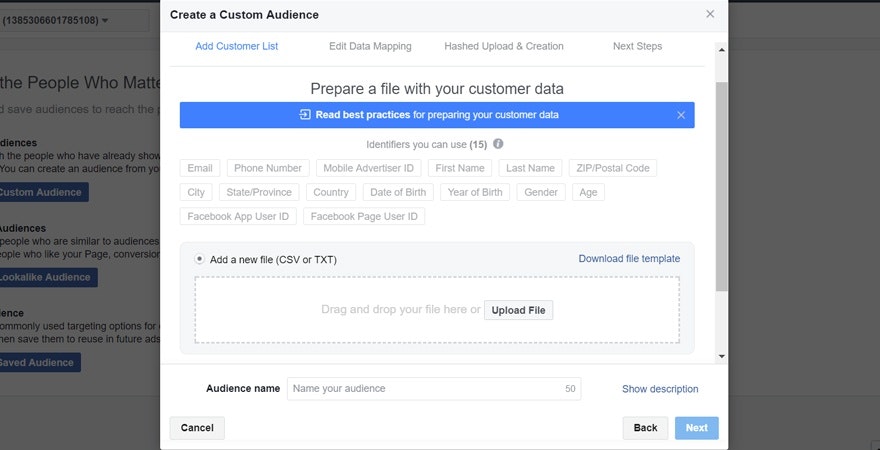
Lookalike Audiences
Lookalike audiences are created using your core audience or custom audience data. Facebook will find other users who are similar, and display your ads to them too.
To create a lookalike audience, go to the “Audiences” tab in the Ads Manager and click “Create Audience” → “Lookalike Audience.” Choose the source you want to mimic, like a custom audience or a Facebook page. You can also choose countries or regions to target.
Choose how closely you want the audience to match: 1 to 10% of the total population in the countries you choose. If you choose 1%, the total number of available users will be smaller, but a closer match. If you choose 10%, you’ll have more available users, but they’ll have less in common with your original audience.
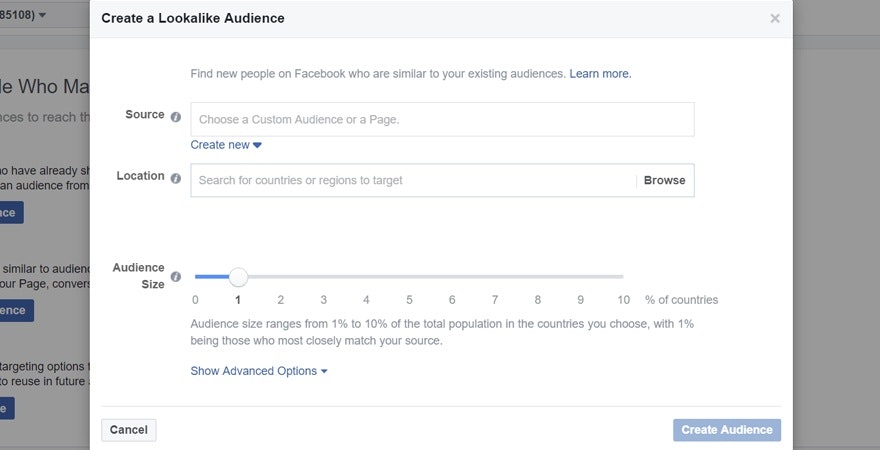
Conclusion
When companies tap into the power of market segmentation, they can transform their business. Companies can stop wasting money on ineffective advertising, while gaining more revenue than ever before. The customer experience will be better, which will make happier customers who keep coming back.
If you don’t use market segmentation, start today using the tips and steps we discussed. There’s no one way to do it – once you create your own market segmentation definition, the possibilities never end.
Do you have any questions about market segmentation? If you’ve already started the process, what’s one tip you’ve learned? Let us know in the comments below.


